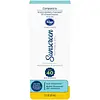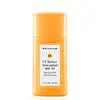What's inside
What's inside
 Key Ingredients
Key Ingredients

 Benefits
Benefits

 Concerns
Concerns

 Ingredients Side-by-side
Ingredients Side-by-side

Butyl Methoxydibenzoylmethane 3%
UV AbsorberHomosalate 11%
Skin ConditioningEthylhexyl Salicylate 5%
UV AbsorberOctocrylene 10%
UV AbsorberDimethicone
EmollientHydrated Silica
AbrasiveIsododecane
EmollientDimethicone Crosspolymer
Emulsion StabilisingButyloctyl Salicylate
Skin ConditioningDisteardimonium Hectorite
StabilisingPolymethylsilsesquioxane
Polymethyl Methacrylate
Polyester-8
Skin ConditioningIsohexadecane
EmollientDimethicone/Vinyl Dimethicone Crosspolymer
Skin ConditioningButyrospermum Parkii Butter
Skin ConditioningLecithin
EmollientPolyglyceryl-4 Isostearate
EmulsifyingCetyl PEG/PPG-10/1 Dimethicone
EmulsifyingHexyl Laurate
EmollientPhenoxyethanol
PreservativeBis-Vinyldimethicone/PEG-10 Dimethicone Crosspolymer
Emulsion StabilisingNeopentyl Glycol Diethylhexanoate
EmollientCitrus Aurantium Dulcis Peel Oil
MaskingTocopherol
AntioxidantParaffinum Liquidum
EmollientAloe Barbadensis Leaf Extract
EmollientButyl Methoxydibenzoylmethane 3%, Homosalate 11%, Ethylhexyl Salicylate 5%, Octocrylene 10%, Dimethicone, Hydrated Silica, Isododecane, Dimethicone Crosspolymer, Butyloctyl Salicylate, Disteardimonium Hectorite, Polymethylsilsesquioxane, Polymethyl Methacrylate, Polyester-8, Isohexadecane, Dimethicone/Vinyl Dimethicone Crosspolymer, Butyrospermum Parkii Butter, Lecithin, Polyglyceryl-4 Isostearate, Cetyl PEG/PPG-10/1 Dimethicone, Hexyl Laurate, Phenoxyethanol, Bis-Vinyldimethicone/PEG-10 Dimethicone Crosspolymer, Neopentyl Glycol Diethylhexanoate, Citrus Aurantium Dulcis Peel Oil, Tocopherol, Paraffinum Liquidum, Aloe Barbadensis Leaf Extract
Butyl Methoxydibenzoylmethane 3%
UV AbsorberHomosalate 10%
Skin ConditioningEthylhexyl Salicylate 5%
UV AbsorberWater
Skin ConditioningIsododecane
EmollientPolymethyl Methacrylate
Butyloctyl Salicylate
Skin ConditioningAcrylates Copolymer
Saccharomyces Ferment
Skin ConditioningAluminum Starch Octenylsuccinate
AbsorbentButylene Glycol
HumectantPolyglyceryl-6 Polyricinoleate
EmulsifyingC24-28 Alkyldimethylsiloxy Trimethylsiloxysilicate
Skin ProtectingPolyglyceryl-2 Dipolyhydroxystearate
Skin ConditioningDisteardimonium Hectorite
StabilisingSodium Chloride
MaskingCaesalpinia Spinosa Fruit Extract
Skin ProtectingHelianthus Annuus Sprout Extract
Skin ConditioningSodium Stearoyl Glutamate
CleansingGlycine Soja Oil
EmollientSqualane
EmollientRaspberry Ketone
MaskingLauroyl Lysine
Skin ConditioningCaprylyl/Capryl Glucoside
CleansingTriethyl Citrate
MaskingPolyglyceryl-10 Dioleate
EmulsifyingHydroxyethylcellulose
Emulsion StabilisingOctyldodecanol
EmollientTocopherol
AntioxidantSodium Phytate
Polysorbate 60
EmulsifyingDisodium Phosphate
BufferingSodium Phosphate
BufferingSodium Benzoate
MaskingCaprylyl Glycol
EmollientPropylene Glycol
HumectantCitric Acid
BufferingPhenoxyethanol
PreservativeButyl Methoxydibenzoylmethane 3%, Homosalate 10%, Ethylhexyl Salicylate 5%, Water, Isododecane, Polymethyl Methacrylate, Butyloctyl Salicylate, Acrylates Copolymer, Saccharomyces Ferment, Aluminum Starch Octenylsuccinate, Butylene Glycol, Polyglyceryl-6 Polyricinoleate, C24-28 Alkyldimethylsiloxy Trimethylsiloxysilicate, Polyglyceryl-2 Dipolyhydroxystearate, Disteardimonium Hectorite, Sodium Chloride, Caesalpinia Spinosa Fruit Extract, Helianthus Annuus Sprout Extract, Sodium Stearoyl Glutamate, Glycine Soja Oil, Squalane, Raspberry Ketone, Lauroyl Lysine, Caprylyl/Capryl Glucoside, Triethyl Citrate, Polyglyceryl-10 Dioleate, Hydroxyethylcellulose, Octyldodecanol, Tocopherol, Sodium Phytate, Polysorbate 60, Disodium Phosphate, Sodium Phosphate, Sodium Benzoate, Caprylyl Glycol, Propylene Glycol, Citric Acid, Phenoxyethanol
Ingredients Explained
These ingredients are found in both products.
Ingredients higher up in an ingredient list are typically present in a larger amount.
Also known as Avobenzone, this ingredient is a chemical sunscreen filter that provides protection in the UV-A range.
Avobenzone is globally approved and is the most commonly used UV-A filter in the world.
Studies have found that avobenzone becomes ineffective when exposed to UV light (it is not photostable; meaning that it breaks down in sunlight). Because of this, formulations that include avobenzone will usually contain stabilizers such as octocrylene.
However, some modern formulations (looking at you, EU!) are able to stabilize avobenzone by coating the molecules.
Avobenzone does not protect against the UV-B range, so it's important to check that the sunscreen you're using contains other UV filters that do!
The highest concentration of avobenzone permitted is 3% in the US, and 5% in the EU.
Learn more about Butyl MethoxydibenzoylmethaneButyloctyl Salicylate is a chemical UV filter structurally similar to octisalate. It is a photostabilizer, SPF booster, emollient and solvent. This ingredient helps evenly spread out ingredients.
According to a manufacturer, it is suitable for pairing with micro Titanium Dioxide, Zinc Oxide, and pigments.
Photostabilizers help stabilize UV-filters and prevents them from degrading quickly.
Learn more about Butyloctyl SalicylateDisteardimonium Hectorite comes from the clay mineral named hectorite. It is used to add thickness to a product.
It can also help stabilize a product by helping to disperse other ingredients.
Hectorite is a rare, white clay mineral.
Learn more about Disteardimonium HectoriteEthylhexyl Salicylate is an organic compound used to block UV rays. It primarily absorbs UVB rays but offers a small amount of UVA protection as well.
Commonly found in sunscreens, Ethylhexyl Salicylate is created from salicylic acid and 2-ethylhexanol. You might know salicylic acid as the effective acne fighter ingredient and BHA.
The ethylhexanol in this ingredient is a fatty alcohol and helps hydrate your skin, similar to oils. It is an emollient, which means it traps moisture into the skin.
According to manufacturers, Ethylhexyl Salicylate absorbs UV wavelength of 295-315 nm, with a peak absorption at 307-310 nm. UVA rays are linked to long term skin damage, such as hyperpigmentation. UVB rays emit more energy and are capable of damaging our DNA. UVB rays cause sunburn.
Learn more about Ethylhexyl SalicylateHomosalate is a chemical sunscreen filter that provides protection in the UV-B range (280nm - 320 nm), with a peak protection at 306 nm. It is internationally approved for use in sunscreens.
Homosalate is not photo-stable, meaning it's strength as a UV filter degrades over time with exposure to the sun. Because of this, it's often used in combination with other chemical sunscreen filters as avobenzone (which protects from the UV-A range). Homosalate also helps act as a solvent for harder-to-dissolve UV filters.
(Part of the reason that sunscreens need to be frequently re-applied is due to the photo instability of many chemical sunscreen filters)
Currently, homosalate is approved in concentrations up to 10% in the EU and 15% in the US. The FDA is currently doing further research on the effects of homosalate, and it is possible that these approved concentrations will change in the future.
Learn more about HomosalateIsododecane is a fragrance, emollient, and solvent.
As an emollient, it helps your skin stay soft and hydrated. Emollients help trap moisture into your skin.
Isododecane's role as a solvent makes it a great texture enhancer. It spreads smoothly on skin and does not leave a sticky feeling behind. Isododecane also helps prevent color transfer in makeup products.
Isododecane is not absorbed into skin.
Learn more about IsododecanePhenoxyethanol is a preservative that has germicide, antimicrobial, and aromatic properties. Studies show that phenoxyethanol can prevent microbial growth. By itself, it has a scent that is similar to that of a rose.
It's often used in formulations along with Caprylyl Glycol to preserve the shelf life of products.
This ingredient is also known as PMMA. It is a polymer microsphere, composed of tiny, perfectly spherical particles formed from repeating units.
In cosmetics, PMMA is mainly used to give a soft or blurring effect. The transparent particles are able to scatter light and help reduce the appearance of fine-lines and imperfections.
PMMA is also able to enhance the texture of products by add a smooth feel.
Learn more about Polymethyl MethacrylateTocopherol (also known as Vitamin E) is a common antioxidant used to help protect the skin from free-radicals and strengthen the skin barrier. It's also fat soluble - this means our skin is great at absorbing it.
Vitamin E also helps keep your natural skin lipids healthy. Your lipid skin barrier naturally consists of lipids, ceramides, and fatty acids. Vitamin E offers extra protection for your skin’s lipid barrier, keeping your skin healthy and nourished.
Another benefit is a bit of UV protection. Vitamin E helps reduce the damage caused by UVB rays. (It should not replace your sunscreen). Combining it with Vitamin C can decrease sunburned cells and hyperpigmentation after UV exposure.
You might have noticed Vitamin E + C often paired together. This is because it is great at stabilizing Vitamin C. Using the two together helps increase the effectiveness of both ingredients.
There are often claims that Vitamin E can reduce/prevent scarring, but these claims haven't been confirmed by scientific research.
Learn more about Tocopherol